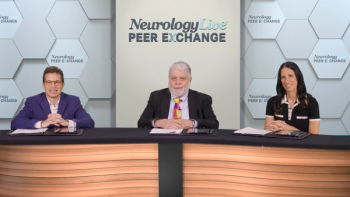
- February 2023
- Volume 6
- Issue 1
Perspectives on Recent Advances in Alzheimer Disease
A panel discusses the latest progress in treatment, current diagnostic processes, and various therapies that have advanced through the pipeline.
THE SCIENTIFIC UNDERSTANDING OF DEMENTIA, particularly Alzheimer disease (AD), has been progressing rapidly since the turn of the century, and the past decade has proven quite fruitful in advancing the ability to improve patients’ lives. An improved understanding of the underlying mechanisms of the disease and better technological tools for diagnosis have cultivated similar progress in developing effective therapeutics—an area that has eluded researchers for years.
In June 2021, the FDA authorized the first disease-modifying medication and major approval for AD in almost 2 decades, aducanumab (Aduhelm; Biogen Inc),1 and in January 2023, the agency approved another, lecanemab (Leqembi; Eisai Co Ltd).2 Although both agents have shown success in acting on their intended targets—clearing amyloid-ß tangles from the brain—challenges and controversies have arisen in discussions about their effects on improving cognition and safety issues, such as amyloid-related imaging abnormalities (ARIAs). Despite some disagreement among experts, approvals of these agents have been regarded as a success for the field and additions to the limited list of therapeutic options for patients with AD.
When improved diagnostic capabilities and the potential of a combination approach with other treatment hopefuls in the pipeline are considered, the state of AD has rarely been better positioned. The timing of this progress could not be better, with a rising patient population looming in the near future.3 With much to discuss as these scenarios come to a head, NeurologyLive® convened a panel of experts in dementia care to share their perspectives on the current treatment paradigm, how clinical care is changing, and what is to come.
Moderated by Marwan Sabbagh, MD, FAAN, a behavioral neurologist in the Alzheimer’s and Memory Disorders Program and a professor in the Department of Neurology at the Barrow Neurological Institute in Phoenix, Arizona, the conversation touched on the current understanding of disease pathology, the novel diagnostic options in the clinic, and the importance of primary care providers in meeting the needs of the patient population.
Current Understanding of Disease Pathology
AD pathology is complex, making it challenging for the science to improve clinicians’ capacity to address the symptoms that affect the patients they see. Panelist Eric McDade, DO, an associate professor of neurology at the Washington University School of Medicine in St Louis, Missouri, explained that some of this complexity has been driven by the role of amyloid-ß plaques. The presence of amyloid-ß deposits is required for a diagnosis of AD, “[but] one of the complexities of Alzheimer disease has been the recognition that, for 40 to 50 years, you can have amyloid pathology in your brain at the time of death and not have symptoms,” McDade said.
This contradiction of pathology and symptomatic presentation has led to challenges in comprehending AD, but the knowledge of amyloid-ß as a fundamental part of the pathologic process is clear. McDade explained that amyloid pathology develops up to 20 years before symptoms have developed—and technological advances have allowed for the visualization of this pathology in cognitively unimpaired adults.
“But what we know about the symptoms, and what’s led to controversy with regard to the role that amyloid plays, is that when we look at the actual symptoms of Alzheimer disease, they’re much more tightly linked to the tau pathology, particularly those neurofibrillary tangles that we see within the cells,” McDade said. “Also, things like synaptic loss are associated with this evidence of excess inflammation in the brain, which is a normal response to having amyloid pathology in the brain. What’s been challenging about this is linking this disease, which develops over 20 years or longer, to differences of when those pathologies develop and how we can subsequently address those.”
At the most recent Clinical Trials on Alzheimer’s Disease Conference, held in late November to early December 2022, some of the newest data were presented that solidify the role of amyloid pathology in AD, even at the symptomatic stage, but the size of that effect is unknown. McDade noted that lowering amyloid results in an effect for patients, but the other components of AD remain unaddressed.
Sabbagh noted that most neurodegenerative diseases are proteinopathies—caused by the accumulation of proteins in organs or organ systems—with AD being an amyloidopathy. McDade said that the proteinopathy perspective allows the field to view AD at a deeper level, beyond only a given disease’s symptoms.
“Proteinopathy is the fundamental component that leads to these diseases,” McDade said. “But it’s the expression, still, that we use traditionally to make the diagnosis. That’s changing as we have ways of measuring these proteins in individuals. We can be more precise. This individual, with this core set of symptoms and abnormal biomarkers associated with these proteins, [has] Alzheimer—which is the alterations in that amyloid pathology and proteinopathy as well as the specific tauopathy. Another individual may develop a Parkinson-like syndrome but have the absence of Alzheimer pathology based on these tests that we use. We can definitively say that this is a Parkinson-associated disorder. We use these to classify the disease more precisely when we think about it. Also, because we can measure those, we can be more specific with how we target them with therapies and know if our therapies are at least hitting that target, and then make assumptions on how that’s related to improvement in the symptoms.”
Diagnostic Pathway for Alzheimer Disease
Just as improvements in pathologic understanding have allowed for more precise understanding of how to classify and treat AD and similar diseases, the advances in imaging technology and assay panels have led to leaps forward in assessing clinical progression. Sabbagh, though, mentioned that challenges persist with the current imaging tools of PET, CT, and MRI. When patients should undergo these tests is another question.
“My clinical approach is that first you need to have an index of suspicion for somebody who may have a concern. Maybe the patient has a concern; maybe the family member has a concern; maybe you have a concern because you’ve seen some changes in cognitive or even medical function. Maybe someone’s medical condition has changed when they’ve been stable for a long time,” said panelist Alireza Atri, MD, PhD, a cognitive neurologist and the director of Banner Sun Health Research Institute in Sun City, Arizona. “We shouldn’t always assume their heart disease is worse, or they have out-of-control diabetes or hypertension. It could be that people aren’t functioning well cognitively. If there’s a concern that has to be worked up, there’s a pathway for doing that, taking a history from the patient and the family member.”
Atri added that as clinicians review patient history and risk, a validated instrument must be used in making a decision. He noted that if a physician is unable to say that there is no cognitive impairment or the next step needs to be taken for another reason, exploring what other factors might be contributing is key. Blood work, he noted, is often an option, and it is important to remember blood as a biomarker tool before undergoing imaging. At that point, he explained, undergoing MRI is vital because of its ability to show white matter damage and other unexpected aspects.
“The other part to look at is atrophy patterns,” Atri said. “If you have atrophy, that’s not something that’s going to happen overnight, and you can rule that in as part of that. The flip side isn’t that you should get a readout that says this is age-appropriate atrophy and white matter changes, and there’s no hippocampal atrophy, which therefore excludes Alzheimer disease. That’s not true. We know that. The positive predictive value is high, and I always encourage my colleagues to look at the MRI themselves. At least look at the FLAIR [fluid-attenuated inversion recovery], because the white on the FLAIR is bad, and you can get a sense for that. That’s a standard for structural [imaging].”
The next step in the diagnostic pathway is to understand the level of the issue. The panel proposed asking questions about the presence of subjective cognitive decline, mild cognitive impairment (MCI), or even mild dementia. It is important to inquire about the effect of these changes on patient independence, and to identify syndrome patterns, to get a clearer probability of other common disorders—such as sleep apnea—playing a role.
“If we need much higher confidence for the diagnosis, then we can go to the biomarkers,” Atri said. “That’s something we were going to need because it’s a prerequisite for appropriate use of drugs that target amyloid. That’s a pathway that’s probably not necessarily for the diagnostic part, but for the risk part, you may need to do APOE ε4 testing. We’ll hear about ARIA risk, for example, which we need to discuss with patients and families but also to make sure individuals have amyloid if you’re going to give them an amyloid drug. You may have options, like CSF [cerebrospinal fluid] or PET scans. Those are the main things we use, but in the future, we’ll be able to use—depending on cost and accessibility—a multiplex to rule a diagnosis in, give prognostication, be able to present the risks and benefits to patients in a way they can make an informed choice and monitor for safety.”
Importance of Primary Care Physicians in AD Diagnosis
Biomarkers become a particularly important aspect of measuring and understanding AD, not only because of their role as targets for novel treatments, but in the overall diagnosis of the disease. With an anticipated patient population of more than 12.7 million by 2050,3 another difficulty is simply meeting the needs of this growing populace with a limited number of specialists available to use these diagnostic tools.
Sharon Cohen, MD, FRCPC, a behavioral neurologist at the University of Toronto and medical director of the Toronto Memory Program, explained that this situation positions primary care physicians as important allies for patients. The need for this group of clinicians to understand the process of AD diagnosis is quite high—regardless of whether primary care is performing all the steps in the diagnostic pathway.
“When a patient comes forward with complaints or concerns, or has significant risk factors and is worried about the risk of Alzheimer disease, one needs to approach the syndrome by asking: Is there cognitive impairment? You need to do some cognitive screening, and you need to decide if this is subjective cognitive decline, if this is mild cognitive impairment [MCI], if this dementia is mild, moderate, or severe,” Cohen said. She noted that from there, it is important to respect that even with a pattern that appears to be one of those syndromes, underlying AD could be the cause, especially with a familial history. But, importantly, getting to a diagnosis of MCI because of AD or probable AD dementia is not enough.
“I’d like our primary care colleagues to understand that it’s not incumbent on them to make the underlying biologic diagnosis— not yet—but to respect that we’re not always going to be right with our syndromic diagnosis. It’s a starting point, and then refer to a specialist in the near term who can take it to the next step and figure out what the underlying cause might be,” Cohen said. Ordering CT or MRI imaging, something that family doctors and nurse practitioners can do, is particularly helpful when there is going to be a referral to a specialist.
“For family doctors who are diligent and ordering an MRI, what they put on the requisition should direct the radiologist. We don’t want to say, ‘Memory loss.’ We want to say, ‘Please rule out hippocampal atrophy.’ You’re going to get an answer that’s nil acute, which doesn’t help us,” Cohen said.
This has yet to be incorporated extensively into trainings and teaching because previously, there has not been a need for this level of involvement from family and primary care medicine. But now, as therapeutic options improve, and early recognition becomes even more crucial to their success, the tandem of specialists and primary care needs to be a strong partnership.
“Family doctors will feel empowered, and they’ll be more motivated to take this disease seriously, if they know they can perform a certain level of the diagnostic work-up and refer on,” Cohen said. “When they refer on, they’re going to need to say something to their patient about why they’re doing that. The more sensible conversations are going to come from some knowledge of the family doctor about what the specialist could add.”
To watch the entire NeurologyLive® Peer Exchange series, scan the QR code or visit,
REFERENCES
FDA’s decision to approve new treatment for Alzheimer’s disease. FDA. June 7, 2021. Accessed January 13, 2023. https://www.fda.gov/drugs/news-events-human-drugs/ fdas-decision-approve-new-treatment-alzheimers-disease
FDA grants accelerated approval for Alzheimer’s disease treatment. News release. FDA. January 6, 2023. Accessed January 13, 2023. https://www.fda.gov/news-events/press-announcements/ fda-grants-accelerated-approval-alzheimers-disease-treatment
2022 Alzheimer’s disease facts and figures. Alzheimers Dement. 2022;18(4):700-789. doi:10.1002/ alz.12638
Articles in this issue
over 2 years ago
Activation of NRF2 and FXN in Friedreich Ataxiaover 2 years ago
From “Diagnose and Adiós” to Brain Health: Are We There Yet?almost 3 years ago
FDA Approves Eisai’s Lecanemab for the Treatment for Alzheimer DiseaseNewsletter
Keep your finger on the pulse of neurology—subscribe to NeurologyLive for expert interviews, new data, and breakthrough treatment updates.





































